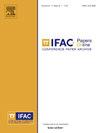Control-Oriented Gray-Box Modeling for Thermoset Injection Molding⁎
Q3 Engineering
引用次数: 0
Abstract
Cavity pressure control can enhance the repeatability of injection molding processes. While extensive research has focused on thermoplastic cavity pressure control, there is a notable gap in models and control strategies for thermoset injection molding. This study aims to develop a model structure for thermoset injection molding suitable for integration into a model-based control scheme. The modeling approach is intended to be as generalizable as possible and sufficiently flexible to adapt to various process conditions. At the same time, it should be easy to parameterize or to train. To address this challenge, we first derive a first-principles process model. In the second step, we integrate a feed-forward artificial neural network into this model, which learns parameters and source terms from past injection molding cycles, resulting in a gray-box model. The neural network outputs replace the initial model parameters with functions of system inputs, states, and time. We validate both models against experimental data from a thermoset injection molding machine using a fat-plate mold geometry and a phenolic resin compound. We identify limitations of the proposed approach and suggest potential solutions.
面向控制的热固性注射成型灰盒建模
型腔压力控制可以提高注射成型过程的重复性。在热塑性注塑模腔压力控制方面已有大量的研究,但在热固性注塑模的模型和控制策略方面还存在明显的空白。本研究的目的是发展一个热固性注射成型的模型结构,适合集成到一个基于模型的控制方案。建模方法的目的是尽可能一般化,并充分灵活地适应各种流程条件。同时,它应该易于参数化或训练。为了应对这一挑战,我们首先推导出一个第一性原理过程模型。在第二步中,我们将前馈人工神经网络集成到该模型中,该模型从过去的注射成型周期中学习参数和源项,从而得到灰盒模型。神经网络输出用系统输入、状态和时间的函数代替初始模型参数。我们验证了两个模型对实验数据从热固性注塑机使用胖板模具几何形状和酚醛树脂化合物。我们确定了所提出方法的局限性,并提出了潜在的解决方案。
本文章由计算机程序翻译,如有差异,请以英文原文为准。
求助全文
约1分钟内获得全文
求助全文
来源期刊

IFAC-PapersOnLine
Engineering-Control and Systems Engineering
CiteScore
1.70
自引率
0.00%
发文量
1122
期刊介绍:
All papers from IFAC meetings are published, in partnership with Elsevier, the IFAC Publisher, in theIFAC-PapersOnLine proceedings series hosted at the ScienceDirect web service. This series includes papers previously published in the IFAC website.The main features of the IFAC-PapersOnLine series are: -Online archive including papers from IFAC Symposia, Congresses, Conferences, and most Workshops. -All papers accepted at the meeting are published in PDF format - searchable and citable. -All papers published on the web site can be cited using the IFAC PapersOnLine ISSN and the individual paper DOI (Digital Object Identifier). The site is Open Access in nature - no charge is made to individuals for reading or downloading. Copyright of all papers belongs to IFAC and must be referenced if derivative journal papers are produced from the conference papers. All papers published in IFAC-PapersOnLine have undergone a peer review selection process according to the IFAC rules.
 求助内容:
求助内容: 应助结果提醒方式:
应助结果提醒方式:


